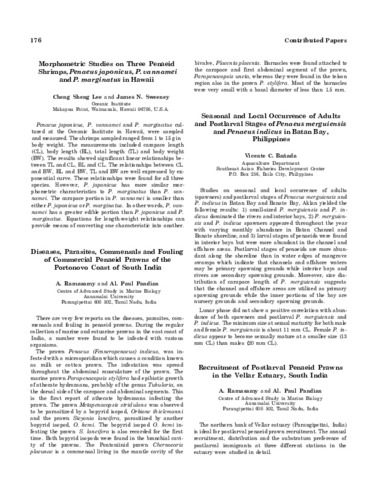Recruitment of postlarval penaeid prawns in the Vellar estuary, South India
Share
Abstract
The northern bank of Vellar estuary (Parangipettai, India) is ideal for postlarval penaeid prawn recruitment. The annual recruitment, distribution and the substratum preference of postlarval immigrants at three different stations in the estuary were studied in detail.
Among the postlarvae of Penaeus, P. (Fenneropenaeus) indicus was dominant followed by P. (Penaeus) monodon, P. (P.) semisulcatus, P. (F.) merguiensis and P. (Melicertus) latisulcatus. In Metapenaeus, postlarvae of M. monoceros were abundant followed by M. dobsoni, M. affinis, M. bre-vicornis and M. lysianassa.
Two peaks were observed in the postlarval penaeid prawn population. In P (F.) indicus and P. (P.) monodon, the primary peak occurred from January to April and the secondary peak from July to September. In M. monoceros and M. dobsoni, the primary peak was from March to May and the secondary peak from August to September. The postlarvae of P. (F.) indicus, P. (P.) monodon, M. monoceros and M. dobsoni were available throughout the year while the others were seasonal. The distribution of postlarvae in the estuary is related to the type of substratum, salinity and temperature. The postlarval population declined during the northeast monsoon (November-December) and in peak summer (May-June). Their abundance decreased in the lower salinity areas of the upper reaches of the estuary.
Description
Abstract only.
Suggested Citation
Ramasamy, A., Pandian, Al.P. (1985). Advances in shrimp culture in China (Abstract only). In Taki Y., Primavera J.H. and Llobrera J.A. (Eds.). Proceedings of the First International Conference on the Culture of Penaeid Prawns/Shrimps, 4-7 December 1984, Iloilo City, Philippines (pp. 176-177). Iloilo City, Philippines: Aquaculture Department, Southeast Asian Fisheries Development Center.

